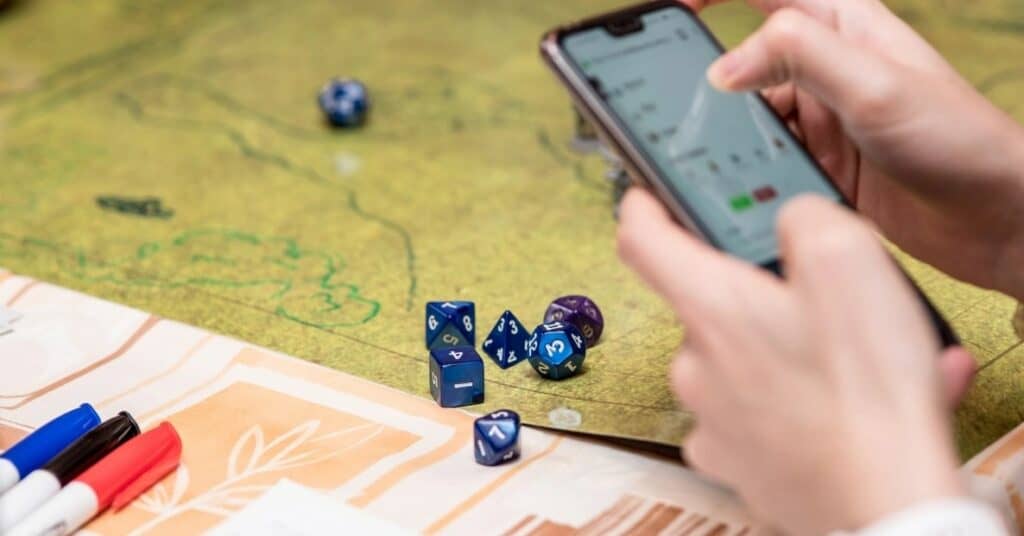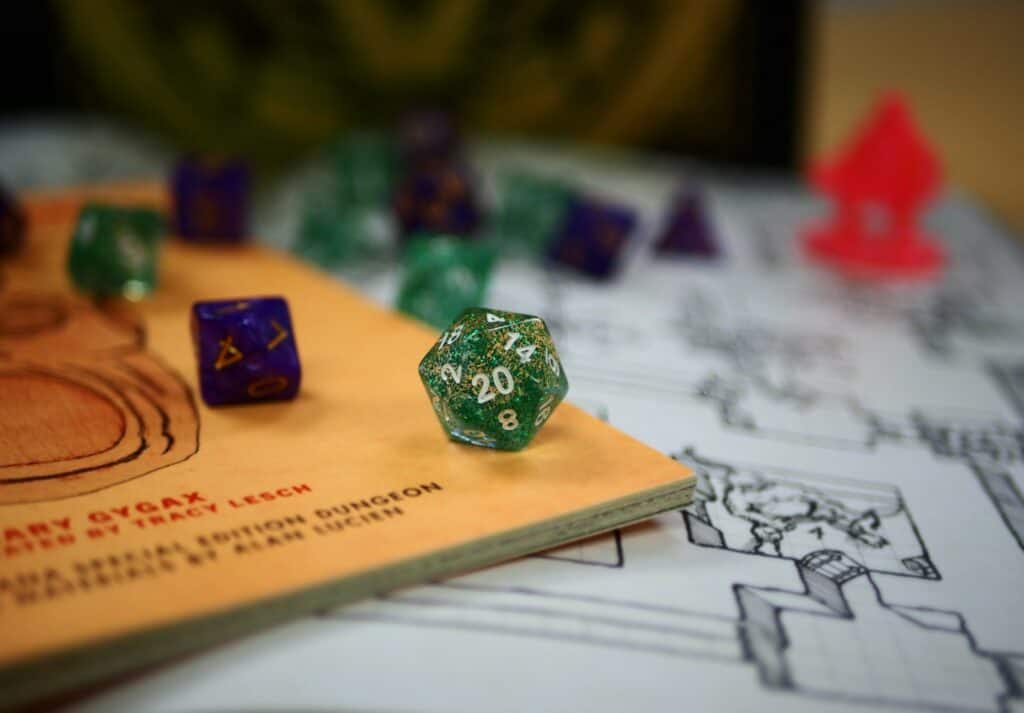As you go into the creepy temple of that drowned god, the surrounding air oppress you. You can’t pinpoint why is that, but your entire party feels the same. As you enter the main hall, the door slam’s shut behind you, and you understand you’re in trouble. A whispering sound echoes throughout the hall, inviting you to leave.
You don’t listen and keep moving forward until you’re about 10 feet from the presbytery. There you see up a stone altar a human form with a red-tinted blanket on top, and getting closer to the crossing, a figure appears. The drow priestess looks at you and with a booming voice that resounds inside the church, she says: “I guess you don’t want to listen to my subtle warnings. Very well then.”.
The earth trembles as her eyes glow with unnatural colors. You don’t muster the courage to stay in that place anymore and run for your lives. You hear in the distance the grotesque laughter of the woman as you get further away from that hunted place. But what you don’t know is that her laughter is genuine, knowing that she scared a bunch of adventurers without using a single D&D spell slot.
Welcome to our Thaumaturgy 5e Guide.
What does “Thaumaturgy” means?
“Thaumaturgy” is a term used to describe a wonder, a magician’s work, or a saint’s miracles. It’s a power granted by something else, a mysterious entity, a god, an ancient power going through someone’s veins, etc. A manifestation of paranormal possession or divine intervention.
The practice of Thaumaturgy in real life goes hand in hand with religion and mystical powers. Throughout history, the term was used, not only to describe the wonders of saints, but also to the practice of science, in a time when lots of people didn’t understand the principles behind some machinery, and attributed those contraptions to the works of devils.
How does Thaumaturgy work in-game?
“Thaumaturgy” is a cantrip or 0 level spell. The casting time is 1 action, the range is 30 feet, the components are verbal, and the duration is 1 minute or instantaneous, depending on the effect. For last, the school is Transmutation. Now let’s see the important part of the spell, the description:
“You manifest a minor wonder, a sign of supernatural power, within range. You create one of the following magical effects within range:
- Your voice booms up to three times as loud as normal for 1 minute.
- You cause flames to flicker, brighten, dim, or change color for 1 minute.
- You cause harmless tremors in the ground for 1 minute.
- You create an instantaneous sound that originates from a point of your choice within range, such as a rumble of thunder, the cry of a raven, or ominous whispers.
- You instantaneously cause an unlocked door or window to fly open or slam shut.
- You alter the appearance of your eyes for 1 minute.
If you cast this spell multiple times, you can have up to three of its 1-minute effects active at a time, and you can dismiss such an effect as an action.”

Breaking down the spell
Okay, let’s do this bit by bit. This is a cantrip, which means that his casters can use it at will without expending a spell slot. This makes it, as with all cantrips, a go-to card to pull out at every moment and get creative without fearing the loss of resources.
Being a standard 1 action spell means that you can use it instantaneously, making it perfect for improvisation in a social situation and even during combat if the situation presents itself.
The range is just 30 feet, which makes it a little short, but the fact that this cantrip can usually be used to bolster your presence or some minor utility like closing doors from the distance makes it good enough.
The components are only verbal, which is great. Needing just one component is one of the strongest assets with this spell because that makes it very easy to cast. As long as you’re not silenced, you can cast it. Doesn’t matter if you’re restrained or grappled, as long as you can use your voice, you can cast it.
The duration of the spell depends on the effect. Some are instantaneous, like the sounds or the door opener. The others may last up to 1 minute and are mostly little effects that can be used for an array of situations. The one-minute duration may be short, but remember that being a cantrip you can recast it indefinitely. The duration is mostly there to force the caster to keep focusing on casting the spell if he’s trying to pull out some shenanigans.
What the school of magic says about the spells
Mechanically, the school the spell is from doesn’t do much, but it says much about the intention of the spell and how it is supposed to work. Transmutation is the school of magic that consists in changing the physical properties of things… which means that this is not an illusion.
These effects are pretty much real things you’re causing and that is important because even if the enemy can see through illusions (like creatures with true sight), they will see your eyes change or your voice boom, you’re not bluffing, you have supernatural capabilities.
Who can use “Thaumaturgy”?
The Thaumaturgy cantrip is available in the Cleric spell list and to the base Tiefling. But this being a cantrip means that ANY character could use it at four-level with the “Magic Initiate” feat. Another “organic” way to get this spell would be with a subclass that has access to the cleric spell list, like the Divine Soul Sorcerer, or using the feature of the Pact of the Tome’s Warlock.
We need to take into account that the important thing about this spell is its flavor. If you’re a fighter and take the magic initiate feat to have a bit of spellcasting, remember you’re taking this from the Cleric spell list. This depends very much on the DM, but maybe your character should have a little connection to a god to explain why suddenly he can use a power that is usually associated with a higher power.
For all the DMs who would like to justify your monster or NPC with supernatural screaming capabilities, in the MM, the monsters that have thaumaturgy are Guardian Nagas, Gruumsh’s Eye Orcs, Sahuagin Sorceresses, Spellcasting Drañas, Lolth sorceresses, Androsphynix, Kuo-Toas spellcasters, and Mommy lords. Acolyte, priests, and fanatics for NPC stat blocks.
A little discussion about its origin
And now I would like to stop a moment to talk about, what I like to call, the “creative transtripstriad (transmutation cantrips triad)”. Thaumaturgy is to Clerics, what Druidcraft is to Druids and Prestidigitation to all the other arcane users. These three transmutation cantrips function very much the same way but with little differences in duration, range, and components. The most important thing with these cantrips is creativity and talk (or argue) to your DM.
What separates those cantrips is mostly theme and of course the variation of effects. A wizard can’t learn Thaumaturgy because it is a manifestation of otherworldly power. It’s just a cantrip, but it demonstrates higher power. In the same way, a Cleric (except for the Nature Domain) can’t use Druidcraft because it’s more of a connection with the spirits of nature than a link to your god.
Getting Creative: The real point of Thaumaturgy

Okay, as we saw, Thaumaturgy is not precisely a combat-oriented cantrip, but rather, a useful tool to flavor your character and bring it up whenever the occasion is presented. And for this cantrip, the occasion could be almost always. Let’s see how this cantrip could perform in the three pillars of the DND game.
Exploration
This category is where this spell probably falls a little short. But that is exactly where the ingenuity comes in. The earth tremors could be used to activate or discover some traps in the floor or to disperse the dust in an old bookshelf. Furthermore, one of my favorite uses of this spell is to communicate simple messages with sounds or the flame flicker effect, kind of like a Morse code.
The effect that would probably work the best would be the window/door open/slam shut. If you’re not sure if the door in front of you has a trap on it, you could open it easily from the distance. This would require DM’s permission, but I would allow it to also open chests and little compartments, that could make a Mimic get angry and end his disguise or activate a glyph of warding from a safe distance.
Combat
As I said, combat is not precisely where this cantrip was made for, but that doesn’t mean that it couldn’t make your character more flavorful during it. Also, if you’re in a situation where you are running from enemies, shutting every door in their faces could be really useful. You could close a door from the distance and a wizard ally could cast a hypnotic pattern when the enemy opens it, the DM could even give them a disadvantage in their rolls.
There’s also the case where you could give the help action (which normally is from 5 feet) from the distance, arguing that you’re confusing your rival with the sound of a blade being swung at his face. You could even trick your enemies in uncountable ways, the sound of footsteps coming from afar suggesting you have a backup or just your menacing voice giving them 5 seconds to run. All things that your DM will determine the outcome.
The juicy one: Social Interactions
Here is where the real potential of this cantrip comes to life. In social interactions, this simple spell could make for an awesome encounter. You basically seem like an otherworldly entity when, in the middle of a conversation, you start changing your eye’s colors. You could pull out some serious schemes with ease.
A Divine Soul Sorceress with a subtle spell can change the color of her eyes in the middle of a conversation to make his interlocutor feel odd about her. Maybe in that way you could set a trap for an NPC, your party knows that is very suspicious and tends to overreact to weird things.
You can be very persuasive in interrogations. Not every person with risks his neck for someone who can bombard his ears with booming voices and strange whispers. Most people will piss their pants if they’re not used to those things.
The issue with Thaumaturgy

Now is time to talk about a fact. The mechanical relevance that Thaumaturgy has depends almost entirely on the DM. More often than not, you’ll need to see how your DM rules this spell. Not every DM would give advantage to an intimidation check just because your voice and eyes are unnatural. Not every DM would give damage if a door gets slam into a goblin’s face.
Before taking this or any other highly subjective spell that does not specify a mechanic like an attack roll or an ability check, talk to your DM. Be upfront with what you expect this cantrip to achieve, and try to have discussions with your DM outside the game. Make sure that your DM would reward creativity.
And for all DMs out there. Let your players feel good with their choices. If you feel that giving advantage is too much for a highly unspecific cantrip, at least give a +2 or something to reward creativity. Beware the pitfall of training your players into mid-maxing as the only alternative to be “good” at the game. And most of all, have fun with the shenanigans your players come with.
Thaumaturgy 5e Guide: FAQs
Question: Is Thaumaturgy a concentration spell?
Answer: No, it doesn’t require concentration for his effects to take place. Furthermore, in the description specifies that you can maintain three of his non-instantaneous effects in place. Combine that with the fact that you can use it in tandem with concentration spells such as mayor image or calm emotions to distract or stop a group of guards.
Question: What is thaumaturgy good for?
Answer: Besides the options earlier discussed, Thaumaturgy can be used in endless ways. Replicate mating calls for some beasts, use the tremors to enhance your allies steps in a town to seem powerful, brighten the candles of a room to see better (advantage on investigation maybe?), open the king’s animal cell door, and let them loose when you’re about to be judged, etc. The list goes as far as your imagination. BE CREATIVE
Question: Can you change your voice with Thaumaturgy?
Answer: The description says, “Your voice booms up to three times as loud as normal for 1 minute.” So in that regard, no. But you can use other spells or the “actor” feat in conjunction with Thaumaturgy to make a booming imitation of the high priest coming close to his disciples. You can also be a kenku using mimicry to replicate any sound but with higher intensity.
- Shadow Blade 5e Guide: The Edgy Sword - October 31, 2022
- Aid 5e Guide: Free Points! - October 1, 2022
- Flaming Sphere 5e Guide: Running Orb of Fiery Chaos: - October 1, 2022

